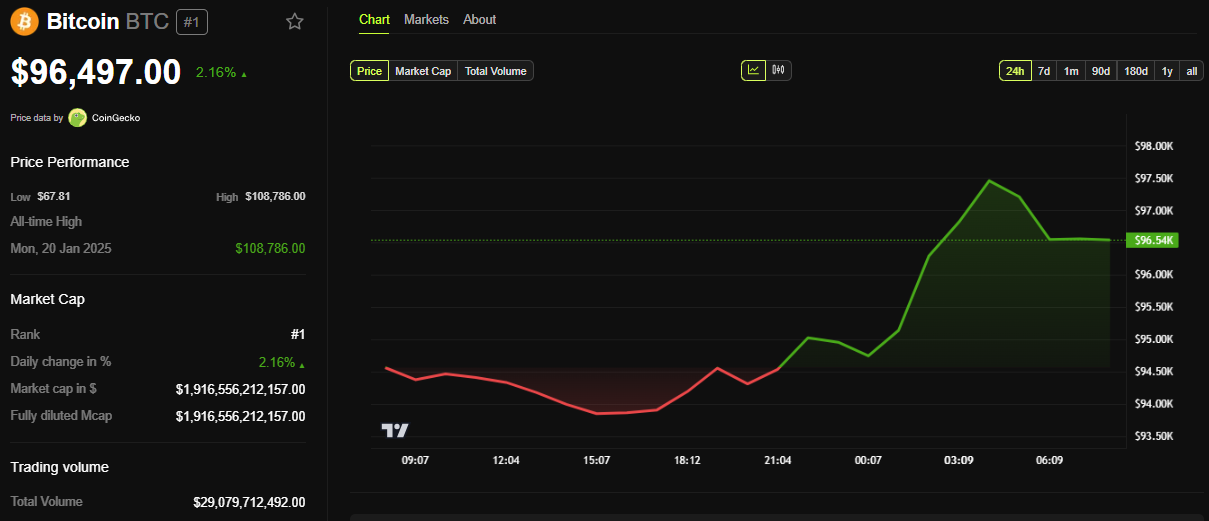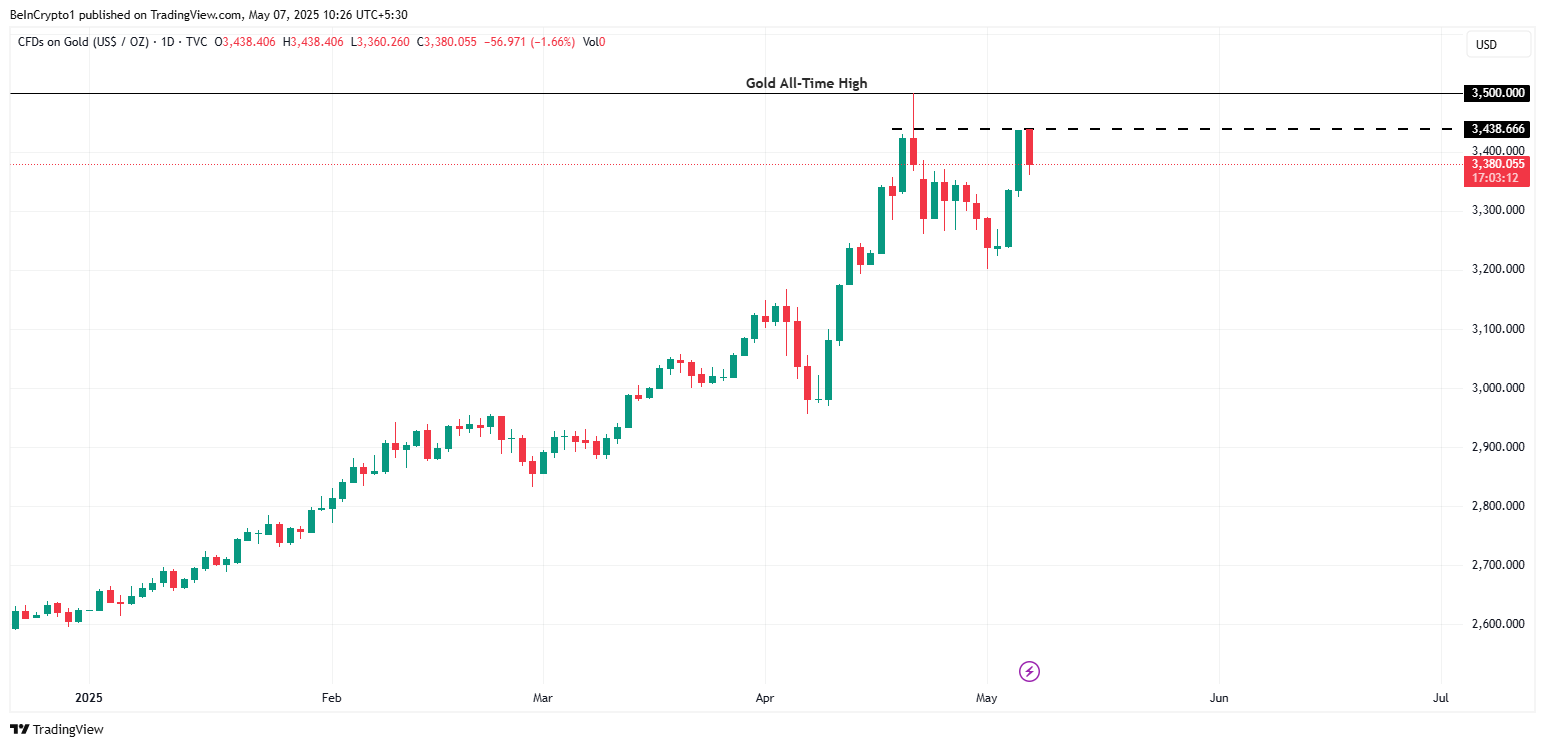| COINOTAG recommends • Exchange signup |
| 💹 Trade with pro tools |
| Fast execution, robust charts, clean risk controls. |
| 👉 Open account → |
| COINOTAG recommends • Exchange signup |
| 🚀 Smooth orders, clear control |
| Advanced order types and market depth in one view. |
| 👉 Create account → |
| COINOTAG recommends • Exchange signup |
| 📈 Clarity in volatile markets |
| Plan entries & exits, manage positions with discipline. |
| 👉 Sign up → |
| COINOTAG recommends • Exchange signup |
| ⚡ Speed, depth, reliability |
| Execute confidently when timing matters. |
| 👉 Open account → |
| COINOTAG recommends • Exchange signup |
| 🧭 A focused workflow for traders |
| Alerts, watchlists, and a repeatable process. |
| 👉 Get started → |
| COINOTAG recommends • Exchange signup |
| ✅ Data‑driven decisions |
| Focus on process—not noise. |
| 👉 Sign up → |
-
Bitcoin surged past $97,000 before pulling back, fueled by China’s massive stimulus package amid anticipations of U.S. Fed policy shifts.
-
Market reactions reflect a renewed risk-on sentiment, primarily driven by interest rate cuts from China and burgeoning trade discussions.
-
According to experts at COINOTAG, “Bitcoin’s volatility showcases its correlation with broader economic events, making it a crucial asset to watch.”
This article delves into Bitcoin’s recent price movements influenced by China’s economic stimulus and potential shifts in U.S. monetary policy, offering key insights for investors.
China’s $138 Billion Stimulus Package Fuels Market Optimism
The People’s Bank of China (PBOC) made significant moves this week by announcing a 0.5 percentage point cut to its reserve requirement ratio, unlocking approximately $138 billion in liquidity. This proactive measure aims to bolster economic activity as recovery signals appear amidst ongoing trade negotiations with the U.S.
The anticipated adjustments included a reduction in interest rates, which not only alleviates borrowing costs but also enhances liquidity across various sectors. Governor Pan Gongsheng emphasized the importance of these cuts during a press conference, noting, “These measures are designed to create a more favorable environment for economic expansion.”
As international trade dynamics shift with upcoming talks between U.S. and Chinese officials, this stimulus is expected to inject confidence into the markets. The immediate fallout was evident as Bitcoin shot up to the crucial $97,000 mark before stabilizing around $96,000.
| COINOTAG recommends • Professional traders group |
| 💎 Join a professional trading community |
| Work with senior traders, research‑backed setups, and risk‑first frameworks. |
| 👉 Join the group → |
| COINOTAG recommends • Professional traders group |
| 📊 Transparent performance, real process |
| Spot strategies with documented months of triple‑digit runs during strong trends; futures plans use defined R:R and sizing. |
| 👉 Get access → |
| COINOTAG recommends • Professional traders group |
| 🧭 Research → Plan → Execute |
| Daily levels, watchlists, and post‑trade reviews to build consistency. |
| 👉 Join now → |
| COINOTAG recommends • Professional traders group |
| 🛡️ Risk comes first |
| Sizing methods, invalidation rules, and R‑multiples baked into every plan. |
| 👉 Start today → |
| COINOTAG recommends • Professional traders group |
| 🧠 Learn the “why” behind each trade |
| Live breakdowns, playbooks, and framework‑first education. |
| 👉 Join the group → |
| COINOTAG recommends • Professional traders group |
| 🚀 Insider • APEX • INNER CIRCLE |
| Choose the depth you need—tools, coaching, and member rooms. |
| 👉 Explore tiers → |

As of now, Bitcoin stands at $96,497, with a modest increase of 2.16% in the last 24 hours, showcasing the coin’s volatility yet persistent appeal as a digital asset.
| COINOTAG recommends • Exchange signup |
| 📈 Clear interface, precise orders |
| Sharp entries & exits with actionable alerts. |
| 👉 Create free account → |
| COINOTAG recommends • Exchange signup |
| 🧠 Smarter tools. Better decisions. |
| Depth analytics and risk features in one view. |
| 👉 Sign up → |
| COINOTAG recommends • Exchange signup |
| 🎯 Take control of entries & exits |
| Set alerts, define stops, execute consistently. |
| 👉 Open account → |
| COINOTAG recommends • Exchange signup |
| 🛠️ From idea to execution |
| Turn setups into plans with practical order types. |
| 👉 Join now → |
| COINOTAG recommends • Exchange signup |
| 📋 Trade your plan |
| Watchlists and routing that support focus. |
| 👉 Get started → |
| COINOTAG recommends • Exchange signup |
| 📊 Precision without the noise |
| Data‑first workflows for active traders. |
| 👉 Sign up → |
Federal Reserve’s Bond Buying Spurs Quantitative Easing Discussions
This week, the Federal Reserve’s unexpected purchase of $34.8 billion in Treasury bonds has raised flags regarding the potential for a renewed quantitative easing (QE) strategy. The Fed purchased $14.8 billion in 10-year notes and an additional $20 billion in 3-year notes in rapid succession, prompting speculation about the central bank’s liquidity strategy amid economic uncertainty.
Experts suggest that these actions signify a stealthy return to QE, despite the lack of official announcements. Arthur Hayes, former CEO of BitMEX, interprets these moves as bullish for Bitcoin, stating that such liquidity injections could elevate Bitcoin’s value significantly. “If the Fed reinstates QE, we could see Bitcoin skies above $250,000 by 2025,” Hayes argued.
| COINOTAG recommends • Traders club |
| ⚡ Futures with discipline |
| Defined R:R, pre‑set invalidation, execution checklists. |
| 👉 Join the club → |
| COINOTAG recommends • Traders club |
| 🎯 Spot strategies that compound |
| Momentum & accumulation frameworks managed with clear risk. |
| 👉 Get access → |
| COINOTAG recommends • Traders club |
| 🏛️ APEX tier for serious traders |
| Deep dives, analyst Q&A, and accountability sprints. |
| 👉 Explore APEX → |
| COINOTAG recommends • Traders club |
| 📈 Real‑time market structure |
| Key levels, liquidity zones, and actionable context. |
| 👉 Join now → |
| COINOTAG recommends • Traders club |
| 🔔 Smart alerts, not noise |
| Context‑rich notifications tied to plans and risk—never hype. |
| 👉 Get access → |
| COINOTAG recommends • Traders club |
| 🤝 Peer review & coaching |
| Hands‑on feedback that sharpens execution and risk control. |
| 👉 Join the club → |
Alternatively, some analysts contest the necessity of QE in the current economic climate, noting that systemic risks appear manageable, and thus, could argue against monetization strategies.

Gold prices have responded sharply to market conditions, nearing an all-time high of $3,437.60 per ounce, indicating that investor sentiment is apprehensive. This dual tendency in precious metals and cryptocurrencies reflects broader unease in the financial markets.
As stakeholders await further insights into U.S. monetary policy, Bitcoin’s initial surge suggests a cautiously optimistic outlook. However, some analysts warn that without a clear direction from Federal Reserve Chair Jerome Powell, price fluctuations might persist.
| COINOTAG recommends • Exchange signup |
| 📈 Clear control for futures |
| Sizing, stops, and scenario planning tools. |
| 👉 Open futures account → |
| COINOTAG recommends • Exchange signup |
| 🧩 Structure your futures trades |
| Define entries & exits with advanced orders. |
| 👉 Sign up → |
| COINOTAG recommends • Exchange signup |
| 🛡️ Control volatility |
| Automate alerts and manage positions with discipline. |
| 👉 Get started → |
| COINOTAG recommends • Exchange signup |
| ⚙️ Execution you can rely on |
| Fast routing and meaningful depth insights. |
| 👉 Create account → |
| COINOTAG recommends • Exchange signup |
| 📒 Plan. Execute. Review. |
| Frameworks for consistent decision‑making. |
| 👉 Join now → |
| COINOTAG recommends • Exchange signup |
| 🧩 Choose clarity over complexity |
| Actionable, pro‑grade tools—no fluff. |
| 👉 Open account → |
Conclusion
The ongoing developments underscore a significant intersection of macroeconomic influences and cryptocurrency markets. With China’s latest liquidity measures promoting risk appetite and the Fed’s bond activities stirring QE discussions, investors should maintain a vigilant watch over these economic indicators. Ensuring you’re informed of the potential implications of these trends can significantly aid in strategic investment decisions.
| COINOTAG recommends • Members‑only research |
| 📌 Curated setups, clearly explained |
| Entry, invalidation, targets, and R:R defined before execution. |
| 👉 Get access → |
| COINOTAG recommends • Members‑only research |
| 🧠 Data‑led decision making |
| Technical + flow + context synthesized into actionable plans. |
| 👉 Join now → |
| COINOTAG recommends • Members‑only research |
| 🧱 Consistency over hype |
| Repeatable rules, realistic expectations, and a calmer mindset. |
| 👉 Get access → |
| COINOTAG recommends • Members‑only research |
| 🕒 Patience is an edge |
| Wait for confirmation and manage risk with checklists. |
| 👉 Join now → |
| COINOTAG recommends • Members‑only research |
| 💼 Professional mentorship |
| Guidance from seasoned traders and structured feedback loops. |
| 👉 Get access → |
| COINOTAG recommends • Members‑only research |
| 🧮 Track • Review • Improve |
| Documented PnL tracking and post‑mortems to accelerate learning. |
| 👉 Join now → |









